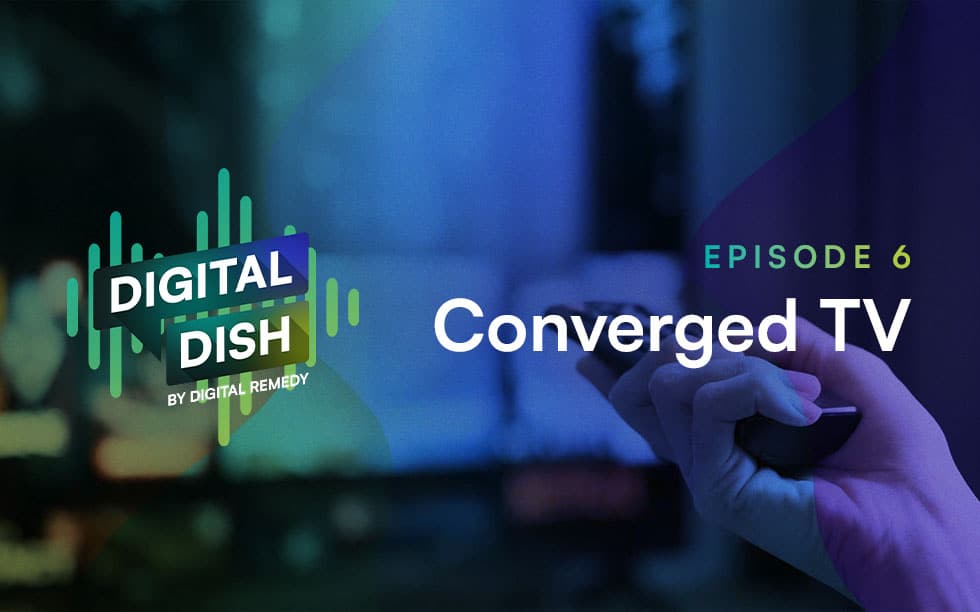Jul 19, 2024
Welcome to the sixth episode of Digital Dish, where we dish on all things adtech. Today we’re talking about one of the industry’s hottest topics, Converged TV. As the TV landscape continues to rapidly change, marketers and advertisers are re-evaluating CTV, linear, and what the future of their media strategies can look like. That’s where…

Welcome to the sixth episode of Digital Dish, where we dish on all things adtech. Today we’re talking about one of the industry’s hottest topics, Converged TV. As the TV landscape continues to rapidly change, marketers and advertisers are re-evaluating CTV, linear, and what the future of their media strategies can look like. That’s where Converged TV comes in.
Prefer to read? Here’s the transcript:
[00:00:00] Caroline Morant, Product Marketing Manager: Welcome to Digital Dish, where we dish on all things ad tech. Today we’re talking about one of the industry’s hottest topics, Converged TV. As the TV landscape continues to rapidly change, marketers and advertisers are reevaluating CTV, Linear and what the future of their marketing strategies can look like.
That’s where Converged TV comes in. Today, we’ll deep dive into what is Converged TV, some industry challenges, linear versus CTV, Converged TV as a solution, and finally, Digital Remedy’s unique Converged TV approach.
[00:00:43] Stephanie Juhas, Sales Manager: At Digital Remedy, we see Converged TV as a holistic approach to activating and measuring marketing strategies across all TV. It takes a distinct media channel like CTV and linear [00:01:00] television out of silos, and it considers how these channels can complement each other to drive stronger performance across the board.
[00:01:08] Jeff DeSimone, Senior Director of Media Strategy: The key here for us is performance. Like with all our media, we take a performance driven approach and merge the lenses of linear and connected television. Measurement is a huge component that drives our Converged TV strategy, but we go beyond that with premium inventory and smarter strategies to drive true action from our insights.
[00:01:30] Matt Engstrom, Vice President of Marketing: So why do advertisers need a Converged TV strategy? A converged approach can help solve several important challenges. First of all, tighter budgets for media and data. Second, deprecation of third party cookies. Third, disconnected fragmented media plus no unified reporting and strategy. And lastly, consistent shifting across platform audience viewership.
In addition to the industry challenges that marketers face, they also [00:02:00] need to be thinking about CTV and linear a little bit differently, as there’s pros and cons to each. So with linear you get unparalleled reach, premium creative, engaged audiences, and trustworthy placements that are guaranteed to be brand safe.
However, there’s some drawbacks as well. First and foremost, it’s very difficult to tie performance to linear exposure, and a lot of times, marketers linear strategy sits outside of its digital strategy.
[00:02:26] Gabby Turyan, Director of Product Marketing: With CTV/OTT, you’ll also reach highly engaged audiences, and you can better measure performance. and lower funnel outcomes.
In general, when it comes to CTV, there are more available insights and transparency. However, some of the challenges with CTV is that it’s disconnected from linear. It’s a fragmented marketplace, and there is more nuance when it comes to activating targeting strategies and deriving true measurement.
[00:02:57] Katie Cladis, Vice President of Product: Converged TV takes the best of both linear [00:03:00] and CTV and allows you to view these channels side by side to optimize the efficiency of both. For example, you can capitalize on widespread reach with linear, but at the same time also drive incremental reach with more targeted CTV campaigns.
[00:03:15] Jeff DeSimone, Senior Director of Media Strategy: A Converged TV approach really allows you to manage and achieve optimal frequency by seeing how often users are being hit on each channel and what is actually driving that needle for you.
Depending on the KPIs, you can also drive stronger, lower funnel performance by honing in on households seeing both linear and CTV ads, since they’re the group most likely to convert.
[00:03:39] Stephanie Reustle, Regional Vice President, Sales – East: At Digital Remedy, we look at Converged TV as an end to end performance approach. It starts with strategic planning and activation on premium inventory for both linear and CTV. Then, we use TV insights to marry the two together and evaluate cross platform measurement. Finally, we take those learnings to [00:04:00] optimize both in real time and for future campaigns.
[00:04:08] Caroline Morant, Product Marketing Manager: At the end of the day, Converged TV isn’t about one definition, one tool, or even one strategy that works best for TV. It’s about being able to see the bigger picture and visualize what CTV and linear are doing separately, but also what they can do together to drive real results. Our goal is to equip advertisers with those tools and empower them to make smarter and more efficient decisions with their TV dollars.
Interested in learning more about our best-in-class service and award-winning media technology? Speak to a team member today.
Catch up on previous Digital Dish episodes on our YouTube page and sign up for our Trends & Insights newsletter for the latest industry updates.
Related Posts

As new tariffs increase economic uncertainty, advertisers are under intense pressure to stretch their budgets and prove the value.

The way people consume television has changed dramatically. With audiences shifting away from traditional cable and toward streaming services,.

Staying ahead as a full-service digital marketing agency is no small feat. Between evolving consumer behaviors, rising client expectations,.